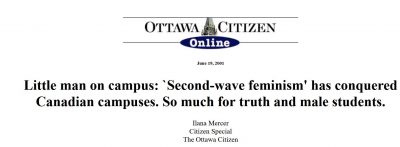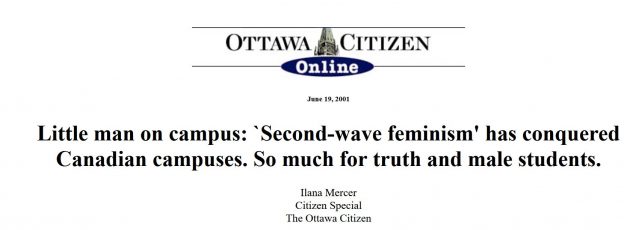
Dr. Veronica Dahl is a professor of computing science at the Simon Fraser University in British Columbia, Canada. While the estimable professor doubtless has considerable expertise in her field, computers were not the topic on which she expounded for the local Knowledge Network. In a taped interview some time back, Prof. Dahl offered that the reason boys were falling behind girls in the school system was that boys were lazy. They know they are the “ruling class,” she said in her deceptively dulcet lilt, and they know that no matter how badly they perform, their position in society is secure.
I followed up with a column in which I identified Dahl’s faux pas with second wave feminism, whereby women are seen as a besieged political class fighting to unseat the ruling class whose members refuse to let go of patriarchal privilege and power. Dahl and colleague, John Dewey Jones, director of the school of engineering science, protested to the editor that I had failed to divine the laudable context of Dahl’s message. Here is the gist of Prof. Jones’ rebuttal: Dahl didn’t say what Mercer alleged she said, but even though she didn’t say what she is alleged to have said, what Dahl didn’t say is accurate (see satire “Yes, Prime Minister”). Plainly, Dewey and Dahl deny the quote, but go on to reinforce its message, namely that girls work hard because of society’s expectations; boys often don’t because they dominate society. Voila, second-wave feminism!
Educators who should know something of the scientific method are advancing opinion guided not by data, but by ideology. Feminism and second wave feminism in particular is an ideology or theory, no more, no less, and a conspiracy theory at that, since it claims that throughout history men have conspired to dominate women.
The current predicament of men certainly contradicts this dogma. Women continue to live longer than men. Five times as many young men as women commit suicide. Men are twice as likely to be unemployed and find it twice as hard to get another job, and men are infinitely more likely to suffer industrial accidents and diseases which may destroy their lives. In addition to being less likely to graduate from high school and go on to college, boys are far more likely to be slapped with the diagnosis of learning disabled than girls and subjected to the Ritalin assault.
Judging from the letters I received from students at SFU, our devoted faculty are blithely unaware of—or heartless about—the experience many men have on campus. Wrote one student:
…I cannot seem to escape the biases of feminism no matter where I turn. Every female teacher somehow manages to bring the argument around to point out that males overrun everything. If I produce any artwork with any sort of tall thin form in it, I immediately am criticized for producing artwork that involves phallic symbolism. Thus meaning that I obviously am promoting male dominance in society.
The academe, once dedicated to freedom of expression and learning, now lets philistines hound males for producing personalized imagery, a reality the young man described as “wearing of his spirits.”
Indeed, radical feminism has engulfed universities, evidently not sparing the hard sciences. Women’s studies courses and English departments have long been littered with the ideology’s lumpen jargon. There, text is routinely deconstructed and shred. Subjected to this academic acid, Shakespeare, Tolstoy, and T. S. Eliot are whittled down to no more than ruling class oppressors, their artistry reduced to the bare bones of alleged power relationships in society. All this glumness is due to a theory, no more, and one based on a partial and insular view of history, at that. Why then is radical feminism touted as immutable truth fit to guide public policy?
Up until the last stages of the industrial revolution, explains Barbara Amiel in her book “Confessions,” societies were preoccupied with the propagation of its members. The division of labour was the culmination of necessity and biology; it was necessary to make the most of man’s superior physical strength and woman’s ability to bear children. For a few children to have survived, explains Amiel, a woman had to give birth to ten or twelve. Were women not pregnant or in labour for most of their arduous lives, the tribe would not have lingered. Men, moreover, have an advantage in the perception of spatial-geometrical relationships. In earlier societies which relied on brute force and in particular on hunting for survival, this advantage was vital.
Feminism is staple doctrine in the secondary schools as well, and it animates the child-centered education system and the 1960s vision its teachers hold. My daughter’s schooling has for the most transmitted sentimentality over reason, attitude and mush over canon and curriculum. She has been forced-fed a pedagogic diet of pop psychology by female teachers who promote every mythical, politically correct orthodoxy that pervades the Zeitgeist.
With their lax standards and shopping mall assortment of flimsy courses, the child-centered, progressive public schools are bad for all children. While being intuitively girl friendly, they are, however, unmistakably boy unfriendly. Some research has indicated that boys thrive in a disciplined, structured, learning environment. The child-centered schooling shuns discipline and moral instruction, and promotes co-operative working habits and groupthink over individual achievement. Boys like competition and are biologically inclined towards it. But when they invariably bubble over with unbridled testosterone, rather than challenge, discipline, and harness their energies, they are all-too-often medicalized and made to conform to a feminized consensus about appropriate behavior. Over the decades, boy biopsychology has been demonized, and boys made over in the emotional image of woman, or at least in the image of the caricature-of-woman feminists promote.
While feminism has become a totem to behold, the biological differences that separate the sexes have become taboo to discuss. As Prof. Doreen Kimura, also of SFU has empirically demonstrated, there is “no evidence for systemic discrimination against women…and that when women do apply for science jobs they get preferential treatment.” Her findings, reported in the National Post, confirm that women “self select out of certain science careers.” Kimura also confirms that men and women differ cognitively in how they solve problems. As I’ve indicated, men, on average, are better at spatial tasks, mathematical reasoning and co-ordination of visual and motor activities. Given these findings, women would never be equally represented in professions such as physics and engineering.
After years of churning out dishonest science on the wage gap, Statistics Canada has finally admitted the pay gap is not due to discrimination, something the Fraser Institute demonstrated almost two decades back. The faulty premise held by public school educators like Dahl and Jones is equally hard to relinquish because it is politically expedient: The fight is on for power, not truth
(An aside: What do you think would have befallen Prof. Dahl had she ventured that the only reason women are underrepresented in the engineering sciences is because they are lazy and know a man will eventually take care of them? I wager the Prof.’s fitness to teach women would have been called into question.)
©2001 By Ilana Mercer
A version of this column appeared in the Ottawa Citizen
June 19
CATEGORIES: Canada, Cultural Marxism, Education & Miseducation, Feminism, Gender Issues, Literature

 print
print